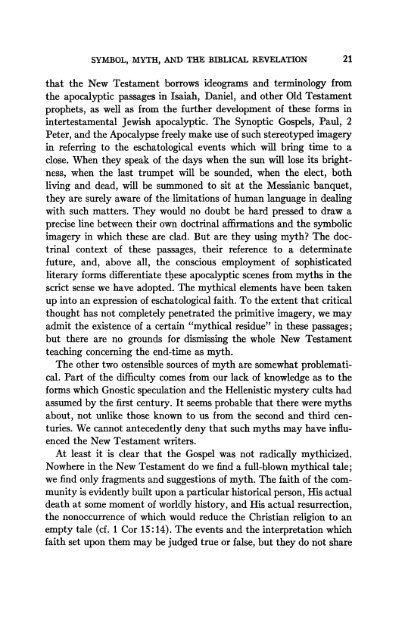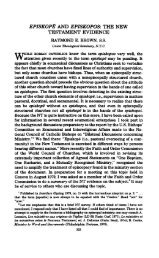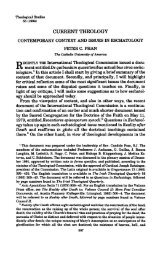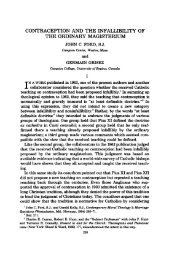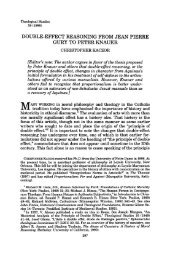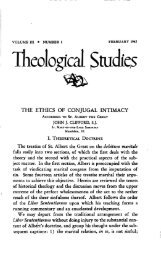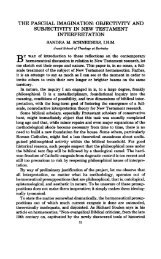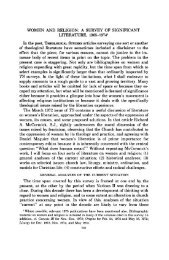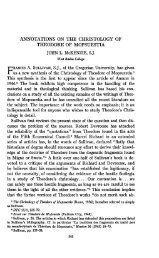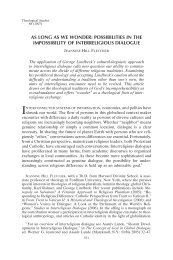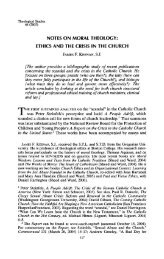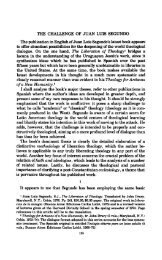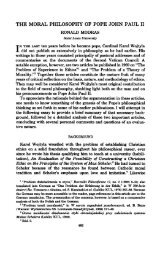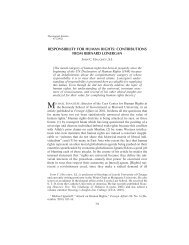SYMBOL, MYTH, AND THE BIBLICAL REVELATION AVERY ...
SYMBOL, MYTH, AND THE BIBLICAL REVELATION AVERY ...
SYMBOL, MYTH, AND THE BIBLICAL REVELATION AVERY ...
Create successful ePaper yourself
Turn your PDF publications into a flip-book with our unique Google optimized e-Paper software.
<strong>SYMBOL</strong>, <strong>MYTH</strong>, <strong>AND</strong> <strong>THE</strong> <strong>BIBLICAL</strong> <strong>REVELATION</strong> 21<br />
that the New Testament borrows ideograms and terminology from<br />
the apocalyptic passages in Isaiah, Daniel, and other Old Testament<br />
prophets, as well as from the further development of these forms in<br />
intertestamental Jewish apocalyptic. The Synoptic Gospels, Paul, 2<br />
Peter, and the Apocalypse freely make use of such stereotyped imagery<br />
in referring to the eschatological events which will bring time to a<br />
close. When they speak of the days when the sun will lose its brightness,<br />
when the last trumpet will be sounded, when the elect, both<br />
living and dead, will be summoned to sit at the Messianic banquet,<br />
they are surely aware of the limitations of human language in dealing<br />
with such matters. They would no doubt be hard pressed to draw a<br />
precise line between their own doctrinal affirmations and the symbolic<br />
imagery in which these are clad. But are they using myth? The doctrinal<br />
context of these passages, their reference to a determinate<br />
future, and, above all, the conscious employment of sophisticated<br />
literary forms differentiate tliese apocalyptic scenes from myths in the<br />
scrict sense we have adopted. The mythical elements have been taken<br />
up into an expression of eschatological faith. To the extent that critical<br />
thought has not completely penetrated the primitive imagery, we may<br />
admit the existence of a certain "mythical residue" in these passages;<br />
but there are no grounds for dismissing the whole New Testament<br />
teaching concerning the end-time as myth.<br />
The other two ostensible sources of myth are somewhat problematical.<br />
Part of the difficulty comes from our lack of knowledge as to the<br />
forms which Gnostic speculation and the Hellenistic mystery cults had<br />
assumed by the first century. It seems probable that there were myths<br />
about, not unlike those known to us from the second and third centuries.<br />
We cannot antecedently deny that such myths may have influenced<br />
the New Testament writers.<br />
At least it is clear that the Gospel was not radically mythicized.<br />
Nowhere in the New Testament do we find a full-blown mythical tale;<br />
we find only fragments and suggestions of myth. The faith of the community<br />
is evidently built upon a particular historical person, His actual<br />
death at some moment of worldly history, and His actual resurrection,<br />
the nonoccurrence of which would reduce the Christian religion to an<br />
empty tale (cf. 1 Cor 15:14). The events and the interpretation which<br />
faith set upon them may be judged true or false, but they do not share


